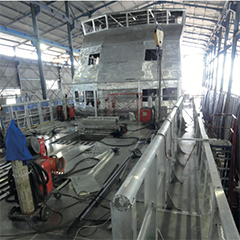Compared to all other vessel type markets worldwide, the Crew Transport Vessel (CTV) is developing the fastest. According to MHO&Co A/S, the perfect CTV has yet to be built and as soon as the next generation is launched, there will be new requirements from a forever developing business. PES was intrigued and went to find out more from, Mik Henriksen, CEO and Dan Knudsen, COO.
It is really interesting to see all the variations that are being built and the different philosophies used by various designers and builders. We have been involved in vessel design for more than 20 years, and it is fantastic to work on transfers to wind farms, where every month new turbines and concepts are being developed.
There are many factors that a client needs to consider when choosing a CTV for a project: safety, operation limitations, comfort, fuel economy, cargo carrying capacity, speed and the day rate, amongst others.
The CTV market has had a few hard years, following on from a some really good years, we are hopeful that the lessons learned during the hard years, will make all involved a bit more careful.
MHO&Co A/S, has chosen to focus on larger CTVs, as wind farms are being placed further and further from shore, we are convinced that larger CTV’s will be needed to operate efficiently, in the conditions found far out at sea. We have been in dialogue with most of the major operators and developers to get input for the design of our new vessels. The design phase has taken about 2 years, but it has been worth it because following on from the consultation we now feel that we know where we can make a difference in the offshore industry.
The first set of vessels are 38,6m long and 10m wide, when we started the project they were only 29m, but more and more things had to be fitted on board. This means the craft are bigger than current CTVs. We have decided to call them FSC39, Fast Supply Catamaran 39m.
We have been working together with Ørsted on the design of these vessels, and the main requirements from that side was to get vessels that can stay offshore for longer periods of time, without taking on fuel from other vessels, and which can operate in the difficult sea conditions, when working so much further offshore.
There has also been a focus on low maintenance, which has resulted in a very high spec propulsion packet, with Cummins KTA38 main engines, which can produce up to 1,500 hp, but in the continuous rating decided on by MHO&Co A/S, they are only attaining 1,000hp. This gives more than twice as many hours between services as the Intermittent rated, or D-rated main engines used in most crew boats. A definite plus.
The requirement to carry more cargo, and to do so safely, can be seen on the vessels, including such features as guard rails all around the cargo deck, to landing cargo safely on the deck.
Due to the much longer water line, the comfort on board is also much better than on traditional CTVs this is very important when transporting personnel that have to do a full day’s work and more, after they have been transferred to the work location.




























